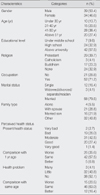Abstract
Purpose
The purpose of this study was to evaluate the effect of an On-line health promotion program connected with a hospital health examination center.
Methods
Based on contents developed, the www.kmwellbeing.com homepage was developed. The research design was a one group pretest-posttest design. Seventy-three clients participated in this study. The data were collected from January 3 to June 30, 2005. As a way of utilizing the homepage, this paper attempted to measure the change of pre and post program health promotion behavior and health status (perceived health status, objective health index-blood pressure, pulse, total cholesterol, blood sugar, waist flexibility, grip strength and lower extremity strength). Data were analyzed by descriptive statistics and paired t-test with the SPSS/Win 12.0 program.
Results
There were significant differences of perceived health status, systolic BP, waist flexibility and grip strength. However, there were no significant differences in health promotion behavior, diastolic BP, pulse, lower extremity strength, blood sugar and total cholesterol between pre program and post program.
Conclusion
It is expected that an on-line health promotion program connected with a hospital health examination center will provide an effective learning media for health education and partially contribute to client's health promotion. A strategy, however, is needed to facilitate the continuous use of the on-line health promotion program for adult clients.
References
1. Ae PH, Sook CI, Min ST, Hyung KJ. Development of a web-based emergency medical information service program for health promotion. Journal of Korean Society of Medical Informatics. 2005. 11:301–312.
2. Aguiar CA. Sol N, Wilson PK, editors. Overall benefits of health promotion to hospital. Hospital Health Promotion. 1989. Champaign: Human Kinetic Books.
3. Chung HT, Kim JA. Utilization of internet-based medical information services and hospital selection among health care consumers: Internet survey. Journal of Korean Society of Medical Informatics. 2005. 11:125–135.

4. Griffith JR. The well-managed healthcare organization. 1999. Chicago, Illinois: Health Administration Press.
5. Jo WH, Lee SG, Park CS, Kang MG, Ham MI, Lee SY. Current status of hospital-based health promotion programs in Korea and the factors influencing their introduction. The Korean Journal of Preventive Medicine. 2001. 34:399–407.
6. Kim JE. Data Collection on Internet. Korean Journal of Nursing Query. 2000. 9:170–185.
7. Lawston MP, Moss M, Fulcomer M, Kleban MH. A research and service oriented multilevel assessment instrument. Journal of Geronotology. 1982. 37:91–99.
8. Lee AK, Lee SY, Kang IO, Jung BK, Han JT, Park IS. The effect of follow-up management service on health promotion: For risk population classified in health screening of national health insurance corporation. Journal of Korean Society Health Education and Promotion. 2007. 24:127–138.
9. McKay HG, King D, Eakin EG, Seeley JR, Glasgow RE. The diabetes network internet-based physical activity intervention: A randomized pilot study. Diabetes Care. 2001. 24:1328–1334.

10. Analysis of health examination result. National Health Insurance Corporation. 2004. Retrieved from http://www.nps.or.kr.
11. 2007 survey on the computer and internet usage. National Internet Development Agency of Korea. 2007. Retrieved from http://www.nida.or.kr.
12. Nguyen HQ, Carrieri-Kohlman V, Rankin SH, Slaughter R, Stulbarg MS. Internet-based patient education and support intervention: A review of evaluation studies and directions for future research. Computers in Biology and Medicine. 2004. 34:95–112.
13. Oh YJ. Development and Evaluation of the Tailored Health Promotion Program for Rural Elderly -Based on the PRECEDE-PROCEED model-. 2003. Daegu: Keimyung University;Unpublished doctoral dissertation.
14. Park HA, Kim HJ, Song MS, Song TM, Chung YC. Development of a web-based health information service system for health promotion in the elderly. Journal of Korean Society of Medical Informatics. 2002. 8:37–45.

15. Park HA, Oh HS, Kim HJ, Park YS, Song TM, Chung YC. Development of a web-based women's health information service system. Journal of Korean Society of Medical Informatics. 2001. 7:47–58.

16. Park JS. The effects of an elderly health promotion program on health promotion lifestyles, health status and quality of life in the elderly service system. Journal of Korean Academy of Nursing. 2004. 34:1194–1204.
17. Park JS, Oh YJ. The effects of a health promotion program in rural elderly on health promotion lifestyle and health status. Journal of Korean Academy of Nursing. 2005. 35:943–954.

18. Park JS, Park MH, Kim JH. Development of on-line health promotion program connected with hospital health examination center. Journal of Korean Society of Medical Informatics. 2006. 12:77–80.
19. Park KS. Health plan 2010 evaluation model and development plan for monitoring system. 2006. In : The Korean Society for Preventive Medicine Symposium; 21–32.
20. Rydell SA, French SA, Fulkerson JA, Neumark-Sztainer D, Gerlach AF, Story M, et al. Use of web-based component of a nutrition and physical activity behavioral intervention with girl scouts. Journal of the American Dietetic Association. 2005. 105:1447–1450.
21. Shin YH, Yun SK. Web-based program development for promotion of exercise among chronic patients. Journal of Korean Society of Medical Informatics. 2005. 11:175–188.

22. Walker SN, Sechrist K, Pender N. HPLP ll. 1995. College of Nursing. University of Nebraska Medical Center.
23. WHO Regional Office for Europe. Hospital and health - Networking into the future report. 1992. WHO workshop held in collaboration with the Hospital Committee of European Community and the University of Linköping.




 PDF
PDF ePub
ePub Citation
Citation Print
Print








 XML Download
XML Download